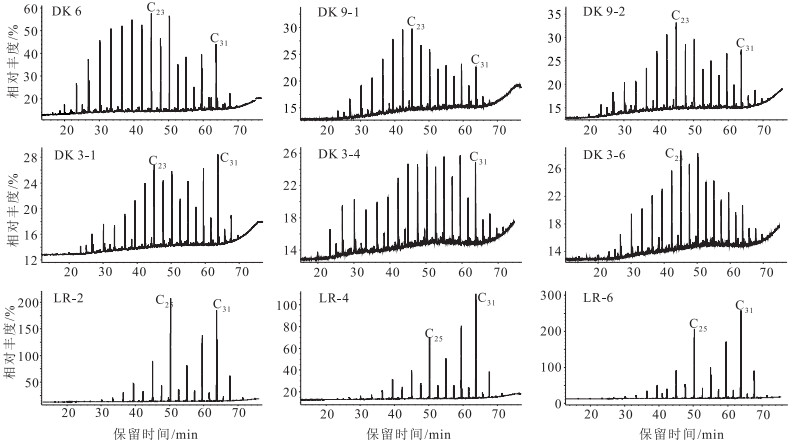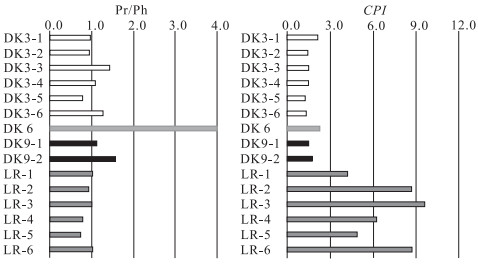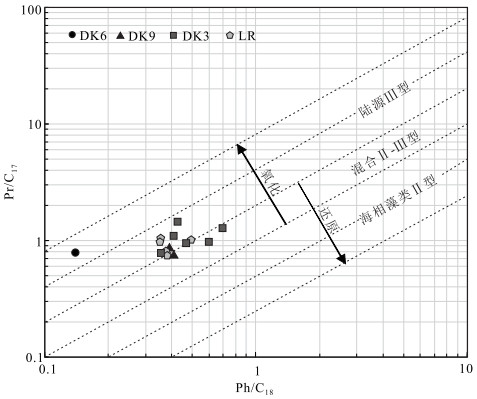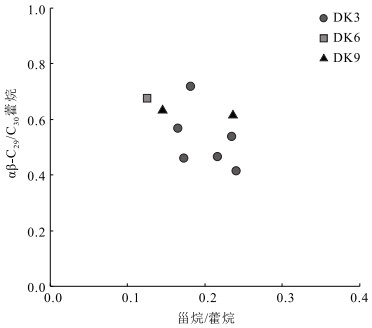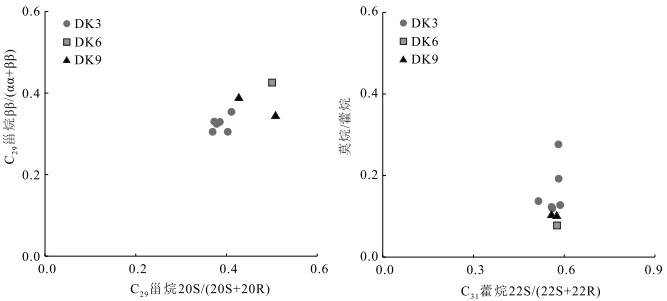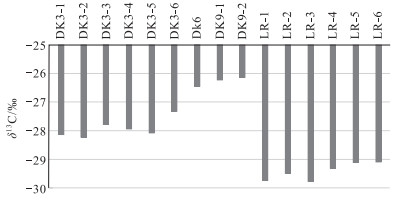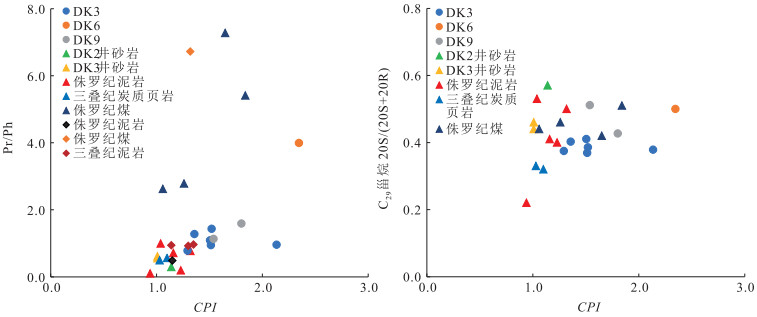Source of soluble organic matter in Quaternary sediments in the Muli permafrost area of the South Qilian basin and its relationship to gas hydrate
-
摘要:
在南祁连盆地木里坳陷钻遇中国陆域第一例天然气水合物实物样品。通过对木里冻土区钻遇水合物区域(DK井区)第四纪沉积物及邻区湖相沉积物中可溶有机质开展有机地球化学分析,发现DK井区浅地表沉积物中明显存在热解成因的可溶有机质,而邻区老人湖湖相沉积物中可溶有机质以高等植物输入为主。与区内烃源岩对比,热解成因的可溶有机质主要来源于中侏罗世烃源岩,晚三叠世尕勒得寺组烃源岩也有一定的贡献。结合该区水合物气源研究成果,DK井区沉积物中可溶有机质与形成水合物的烃类气体可能属于同源,侏罗纪、三叠纪烃源岩热演化生成的烃类能够沿断裂、砂岩裂隙等通道向上运移或渗漏至浅地表,其中甲烷、重烃气等轻质组分能够在稳定带内与地层水结合形成天然气水合物。木里地区第四纪沉积物中可溶有机质的来源解析能够为天然气水合物的勘探提供新的视角。
Abstract:Muli depression in the South Qilian basin is an area where the first natural gas hydrate sample was drilled in land area in China.Organic geochemical analysis was carried out on the soluble organic matter in the Quaternary sediments in gas hydrate-drilled area (DK well area) as well as the Quaternary sediments in adjacent Laoren lake area in the Muli permafrost area.The results show that pyrogenic organic matter obviously exists in shallow surface sediment in the DK well area, while the soluble organic matter in the sediments of Laoren Lake is mainly derived from higher plants.Compared with the characteristics of source rocks in this area, the pyrogenic organic matter mainly comes from the Middle Jurassic source rock, and the Upper Triassic Galerdesi source rock also has a certain contribution.Combined with the research results of hydrate gas source in the study area, the pyrogenic organic matter in Quaternary sediments in the DK well area is probably homologous to hydrocarbon gases that form hydrates.Oil and gas generated by thermal evolution of deep source rocks migrate upward or leak to shallow surface along channels such as faults and sandstone fissures.The light components of methane and heavy hydrocarbon gas can combine with formation water to form gas hydrate in the stable zone.The research on the source of soluble organic matter in the Quaternary sediments in the Muli area can provide a new perspective for the exploration of gas hydrate.
-
Keywords:
- Muli permafrost area /
- Quaternary sediment /
- soluble organic matter /
- thermal maturity /
- gas hydrate
-
致谢: 感谢中国地质调查局物化探所方慧教授级高工在成文过程中给与的指导和帮助,感谢审稿专家提出的建设性修改意见和建议。
-
表 1 木里地区第四纪沉积物样品特征
Table 1 Features of Quaternary sediment samples in Muli area
取样位置 样品编号 深度/cm 与冻土的关系 样品特征 DK3井 DK3-1 53 融冻层内 灰黄色细粒粘土 DK3井 DK3-2 80 融冻层内 灰黄色细粒粘土 DK3井 DK3-3 100 冻土层内 灰黄色细粒粘土 DK3井 DK3-4 129 冻土层内 灰黄色细粒粘土 DK3井 DK3-5 149 冻土层内 灰黄色细粒粘土 DK3井 DK3-6 180 冻土层内 灰黄色细粒沙土 DK6井 DK6 73 融冻层内 灰黑色细粒腐泥 DK9井 DK9-1 49 融冻层内 灰黄色细粒沙土 DK9井 DK9-2 97 融冻层内 灰黄色细粒沙土 老人湖 LR-1 66 融冻层内 黑色粘土,含植物根系 老人湖 LR-2 151 冻土层内 红褐色细粒粘土,含冰 老人湖 LR-3 210 冻土层内 红褐色细粒粘土,含冰 老人湖 LR-4 268 冻土层内 黑色细粒粘土,含冰 老人湖 LR-5 321 冻土层内 黑色细粒粘土,含冰 老人湖 LR-6 395 冻土层内 黑色细粒粘土,含冰 -
方慧, 孙忠军, 徐明才, 等.冻土区天然气水合物勘查技术研究主要进展与成果[J].物探与化探, 2017, 41(6):991-997. http://www.wanfangdata.com.cn/details/detail.do?_type=perio&id=wtyht201706001 祝有海, 张永勤, 文怀军.祁连山冻土区天然气水合物科学钻探工程概况[J].地质通报, 2011, 30(12):1816-1822. http://www.wanfangdata.com.cn/details/detail.do?_type=perio&id=zgqydz201112002 王平康, 祝有海, 卢振权, 等.青海祁连山冻土区天然气水合物研究进展综述[J].中国科学:物理学力学天文学, 2019, 49(3):76-95. http://www.wanfangdata.com.cn/details/detail.do?_type=perio&id=zgkx-cg201903005 孙忠军, 杨志斌, 秦爱华, 等.中纬度带天然气水合物地球化学勘查技术[J].吉林大学学报(地球科学版), 2014, 44(4):1063-1070. http://www.wanfangdata.com.cn/details/detail.do?_type=perio&id=cckjdxxb201404001 邢学文, 刘松, 周红英, 等.木里冻土带天然气水合物赋存区浅层土壤地球化学特征及指示意义[J].石油与天然气地质, 2014, 35(1):159-166. http://www.wanfangdata.com.cn/details/detail.do?_type=perio&id=syytrqdz201401021 牛滨华, 孙春岩, 苏新, 等.勘查地球化学方法适用于勘查天然气水合物的依据[J].现代地质, 2005(1):61-66. http://www.wanfangdata.com.cn/details/detail.do?_type=perio&id=xddz200501009 王平康, 祝有海, 卢振权, 等.祁连山冻土区天然气水合物岩性和分布特征[J].地质通报, 2011, 30(12):1839-1850. http://www.wanfangdata.com.cn/details/detail.do?_type=perio&id=zgqydz201112005 卢振权, 祝有海, 张永勤, 等.青海祁连山冻土区天然气水合物的气体成因研究[J].现代地质, 2010, 24(3):581-588. http://www.wanfangdata.com.cn/details/detail.do?_type=perio&id=xddz201003024 卢振权, 祝有海, 张永勤, 等.青海省祁连山冻土区天然气水合物基本地质特征[J].矿床地质, 2010, 29(1):182-191. http://www.wanfangdata.com.cn/details/detail.do?_type=perio&id=kcdz201001017 张鹏辉, 方慧, 白大为, 等.木里冻土区天然气水合物成藏特征[J].东北石油大学学报, 2018, 42(1):24-31, 76, 122-123. http://www.wanfangdata.com.cn/details/detail.do?_type=perio&id=dqsyxyxb201801003 余丽燕, 韩秀秀, 黄晓虎, 等.滇池不同湖区沉积物正构烷烃的分布特征及其环境意义[J].环境科学, 2016, 37(12):4605-4614. http://www.wanfangdata.com.cn/details/detail.do?_type=perio&id=hjkx201612018 Tissot B P, Welte D H.Petroleum formation and occurrence[M].Springer Science & Business Media, 2013.
Moldowan J M, Seifert W K, Gallegos E J.Relationship between petroleum composition and depositional environment of petroleum source rocks[J].American Association of Petroleum Geologists Bulletin, 1985, 69:1255-1268. https://www.researchgate.net/publication/264739307_Relationship_between_petroleum_composition_and_depositional_environment_of_petroleum_source_rock
Peters K E, Walters CC, Moldowan J M.The biomarker guide[M].Cambridge University Press, 2005.
Seifert W K, Moldowan J M, Jones R W.Application of biological marker chemistry to petroleum exploration[C]//Proceedings of the Tenth World Petroleum Congress, 1980: 425-440.
Onstad G D, Canfield D E, Quay P D, et al.Sources of particulate organic matter in rivers from the continental USA:lignin phenol and stable carbon isotope compositions[J].Geochimica et Cosmochimica Acta, 2000, 64(20):3539-3546. https://www.researchgate.net/publication/222546787_Sources_of_particulate_organic_matter_in_rivers_from_the_continental_USA_Lignin_phenol_and_stable_carbon_isotope_compositions
王培荣.烃源岩与原油中轻馏分烃测定及其地球化学应用[M].北京:石油工业出版社, 2011. 张家政, 祝有海, 黄霞, 等.南祁连盆地木里冻土区天然气水合物烃源岩特征及评价[J].地质通报, 2017, 36(4):634-643. http://www.wanfangdata.com.cn/details/detail.do?_type=perio&id=zgqydz201704017 龚文强, 张永生, 宋天锐, 等.南祁连盆地木里凹陷侏罗系烃源岩沉积环境与生烃潜力[J].中国地质, 2014, 41(1):215-221. http://www.wanfangdata.com.cn/details/detail.do?_type=perio&id=zgdizhi201401017 程青松, 龚建明, 张敏, 等.祁连山冻土区木里煤田侏罗系烃源岩地球化学特征[J].现代地质, 2016, 30(6):1408-1416. http://www.wanfangdata.com.cn/details/detail.do?_type=perio&id=xddz201606023 张晶晶.木里盆地DK9井岩石学与微量元素地球化学特征及沉积环境[D].中国海洋大学硕士学位论文, 2015. 袁二军, 崔彬, 冯小伟, 等.南祁连盆地东北部木里地区三叠系尕勒得寺组烃源岩评价[J].中国矿业, 2013, 22(S1):163-167. http://www.wanfangdata.com.cn/details/detail.do?_type=perio&id=zgky2013z1041 范东稳, 卢振权, 肖睿, 等.南祁连盆地木里坳陷石炭系-侏罗系天然气水合物潜在气源岩地质特征[J].现代地质, 2018, 32(5):985-994. http://www.cnki.com.cn/Article/CJFDTotal-XDDZ201805011.htm 孟康, 金敏波, 徐亮, 等.南祁连木里冻土区天然气水合物气源探讨[J].矿物岩石地球化学通报, 2020, 39(1):72-79. 张家政, 李胜利, 王明君, 等.南祁连盆地木里冻土区天然气水合物气源分析[J].海洋地质与第四纪地质, 2017, 37(5):90-101. http://www.wanfangdata.com.cn/details/detail.do?_type=perio&id=hydzydsjdz201705010 黄霞, 祝有海, 王平康, 等.祁连山冻土区天然气水合物烃类气体组分的特征和成因[J].地质通报, 2011, 30(12):1851-1856. http://www.wanfangdata.com.cn/details/detail.do?_type=perio&id=zgqydz201112006 张敏, 何瑜, 陈祖林, 等.祁连山冻土区天然气水合物中轻烃分析方法及应用[J].石油实验地质, 2018, 40(3):418-423. http://www.wanfangdata.com.cn/details/detail.do?_type=perio&id=sysydz201803016 谭富荣, 刘世明, 崔伟雄, 等.木里煤田聚乎更矿区天然气水合物气源探讨[J].地质学报, 2017, 91(5):1158-1167. http://www.wanfangdata.com.cn/details/detail.do?_type=perio&id=dizhixb201705015 唐世琪, 卢振权, 王伟超, 等.青海木里三露天天然气水合物气源岩有机地球化学特征[J].现代地质, 2015, (5):234-242. http://www.wanfangdata.com.cn/details/detail.do?_type=perio&id=xddz201505026 于常青, 王琪, 卢振权, 等.青海木里地区天然气水合物三维地震探测[J].现代地质, 2015, 29(5):1130-1137. http://www.wanfangdata.com.cn/details/detail.do?_type=perio&id=xddz201505015 王平康, 祝有海, 卢振权, 等.祁连山冻土区天然气水合物成藏体系中自生黄铁矿地球化学特征与成因探讨[J].中国科学:地球科学, 2014, 44(6):1283-1297. http://www.wanfangdata.com.cn/details/detail.do?_type=perio&id=zgkx-cd201406019 蔡俊军, 卢振权, 何家雄, 等.祁连山冻土区天然气水合物伴生碳酸盐岩的地球化学特征[J].天然气工业, 2014, 34(2):143-153. http://www.wanfangdata.com.cn/details/detail.do?_type=perio&id=trqgy201402023 褚厚娟, 郝纯, 邓诗财, 等.木里地区水合物轻烃微渗漏微生物群落及烃氧化菌响应特征研究[J].物探与化探, 2017, (6):52-58. http://www.wanfangdata.com.cn/details/detail.do?_type=perio&id=wtyht201706007



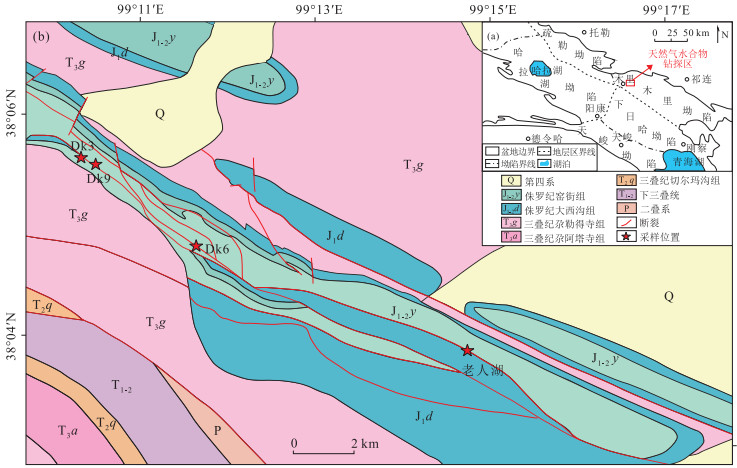
 下载:
下载:
